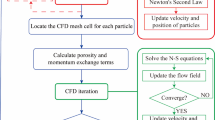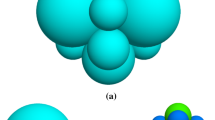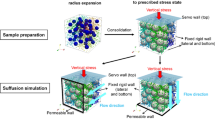Abstract
Behaviour of granular soils subjected to internal erosion involves complex coupling between solid–fluid interaction, skeleton deformation and microstructural evolutions. This paper presents a micro–macro investigation on suffusion in idealized gap-graded and well-graded soils using the coupled computational fluid dynamics and discrete element method. The interaction between soil particles and seepage flow is modelled via momentum exchange between two phases. The progressive loss of fine particles subjected to upward seepage flow at various hydraulic gradients is investigated. The fines content, volumetric contraction and void ratio are monitored to identify the changes of macroscopic states of the soil skeleton. In addition, the microstructural evolution is tracked via particle-scale descriptors such as coordination numbers and force chain statistics. Several clogging–unclogging events which are responsible for the sudden changes of fines content and skeleton response are observed during suffusion. A parametric study indicates that the initial fines content and the hydraulic gradient significantly affect the kinetics of suffusion. Microstructural analyses reveal that the removal of fines is accompanied by the reduction in weak contact pairs and particles with low connectivity.


















Similar content being viewed by others
References
Aboul Hosn R, Sibille L, Benahmed N, Chareyre B (2017) Discrete numerical modelling of loose soil with spherical particles and interparticle rolling friction. Granul Matter 19:1–12
Aboul Hosn R, Sibille L, Benahmed N, Chareyre B (2018) A discrete numerical model involving partial fluid–solid coupling to describe suffusion effects in soils. Comput Geotech 95:30–39
Ai J, Chen JF, Rotter JM, Ooi JY (2011) Assessment of rolling resistance models in discrete element simulations. Powder Technol 206:269–282
Bendahmane F, Marot D, Alexis A (2008) Experimental parametric study of suffusion and backward erosion. J Geotech Geoenviron Eng 134(1):57–67
Chang DS (2012) Internal erosion and overtopping erosion of earth dams and landslide dams. Dissertation, Hong Kong University of Science and Technology
Chang CS, Meidani M (2013) Dominant grains network and behaviour of sand–silt mixtures: stress–strain modelling. Int J Numer Anal Methods Geomech 37:2563–2589
Chang DS, Zhang LM (2013) Extended internal stability criteria for soils under seepage. Soils Found 53(4):569–583
Chang DS, Zhang LM (2013) Critical hydraulic gradients of internal erosion under complex stress states. J Geotech Geoenviron Eng 139:1454–1467
Chen C, Zhang LM, Chang DS (2016) Stress–strain behaviour of granular soils subjected to internal erosion. J Geotech Geoenviron Eng 142(12):6016014
Cividini A, Gioda G (2004) Finite-element approach to the erosion and transport of fine particles in granular soils. Int J Geomech 4:191–198
Di Felice R (1994) The voidage function for fluid–particle interaction systems. Int J Multiphase Flow 20:153–159
Ding WT, Xu W (2018) Study on the multiphase fluid–solid interaction in granular materials based on an LBM–DEM coupled method. Powder Technol 314:129–139
El Shamy U, Aydin F (2008) Multiscale modelling of flood-induced piping in river levees. J Geotech Geoenviron Eng 134:1385–1398
Fannin RJ, Moffat R (2006) Observations on internal stability of cohesionless soils. Géotechnique 56:497–500
Fell R, Fry JJ (2013) State of the art on the likelihood of internal erosion of dams and levees by means of testing. In: Bonelli S (ed) Erosion in geomechanics applied to dams and levees. ISTE-Wiley, London, pp 1–99
Foster M, Fell R, Spannagle M (2000) The statistics of embankment dam failures and accidents. Can Geotech J 37:1000–1024
Fry JJ (2012) Introduction to the process of internal erosion in hydraulic structures: embankment dams and dikes. In: Bonelli S (ed) Erosion of geomaterials. ISTE-Wiley, London, pp 1–36
Goniva C, Kloss C, Deen NG et al (2012) Influence of rolling friction on single spout fluidized bed simulation. Particuology 10:582–591
Hicher PY (2013) Modelling the impact of particle removal on granular material behaviour. Géotechnique 63:118–128
Horikoshi K, Takahashi A (2015) Suffusion-induced change in spatial distribution of fine fractions in embankment subjected to seepage flow. Soils Found 55:1293–1304
Huang H, Zhang F, Callahan P, Ayoub J (2012) Granular fingering in fluid injection into dense granular media in a Hele–Shaw cell. Phys Rev Lett 108:1–4
Jiang MD, Yang ZX, Barreto D, Xie YH (2018) The influence of particle-size distribution on critical state behavior of spherical and non-spherical particle assemblies. Granul Matter 20:1–15
Kawano K, Shire T, O’Sullivan C (2018) Coupled particle–fluid simulations of the initiation of suffusion. Soils Found 58:972–985
Ke L, Takahashi A (2014) Experimental investigations on suffusion characteristics and its mechanical consequences on saturated cohesionless soil. Soils Found 54:713–730
Kenney TC, Lau D (1985) Internal stability of granular filters. Can Geotech J 22:215–225
Kézdi Á (1979) Soil physics: selected topics. Elsevier, Amsterdam
Kloss C, Goniva C, Hager A et al (2012) Models, algorithms and validation for opensource DEM and CFD–DEM. Prog Comput Fluid Dyn Int J 12:140–152
Langroudi MF, Soroush A, Shourijeh PT, Shafipour R (2013) Stress transmission in internally unstable gap-graded soils using discrete element modelling. Powder Technol 247:161–171
Langroudi MF, Soroush A, Shourijeh PT (2015) A comparison of micromechanical assessments with internal stability/instability criteria for soils. Powder Technol 276:66–79
Li M, Fannin RJ (2012) A theoretical envelope for internal instability of cohesionless soil. Géotechnique 62:77–80
Li X, Zhao J (2018) Dam-break of mixtures consisting of non-Newtonian liquids and granular particles. Powder Technol 338:493–505
Moffat R, Fannin RJ (2011) A hydromechanical relation governing internal stability of cohesionless soil. Can Geotech J 48:413–424
Muir Wood D, Maeda K (2008) Changing grading of soil: effect on critical states. Acta Geotech 3:3–14
Muir Wood D, Maeda K, Nukudani E (2010) Modelling mechanical consequences of erosion. Géotechnique 60:447–457
O’Sullivan C, Bray JD, Riemer MF (2002) Influence of particle shape and surface friction variability on response of rod-shaped particulate media. J Eng Mech 128:1182–1192
Ouyang M, Takahashi A (2015) Influence of initial fines content on fabric of soils subjected to internal erosion. Can Geotech J 15:1–15
Reddi LN, Ming X, Hajra MG, Lee IM (2000) Permeability reduction of soil filters due to physical clogging. J Geotech Geoenviron Eng 126:236–246
Richards KS, Reddy KR (2012) Experimental investigation of initiation of backward erosion piping in soils. Géotechnique 62:933–942
Sato M, Kuwano R (2015) Suffusion and clogging by one-dimensional seepage tests on cohesive soil. Soils Found 55:1427–1440
Scholtès L, Hicher PY, Sibille L (2010) Multiscale approaches to describe mechanical responses induced by particle removal in granular materials. Comptes Rendus Mécanique 338:627–638
Shafipour R, Soroush A (2008) Fluid coupled-DEM modelling of undrained behaviour of granular media. Comput Geotech 35:673–685
Shan T, Zhao J (2014) A coupled CFD–DEM analysis of granular flow impacting on a water reservoir. Acta Mech 225:2449–2470
Sharma N, Patankar NA (2005) A fast computation technique for the direct numerical simulation of rigid particulate flows. J Comput Phys 205:439–457
Shire T, O’Sullivan C (2013) Micromechanical assessment of an internal stability criterion. Acta Geotech 8:81–90
Sibille L, Marot D, Sail Y (2015) A description of internal erosion by suffusion and induced settlements on cohesionless granular matter. Acta Geotech 10:735–748
Skempton AW, Brogan JM (1994) Experiments on piping in sandy gravels. Géotechnique 44(3):449–460
Sterpi D (2003) Effects of the erosion and transport of fine particles due to seepage flow. Int J Geomech 3:111–122
Tao H, Tao J (2017) Quantitative analysis of piping erosion micro-mechanisms with coupled CFD and DEM method. Acta Geotech 12:573–592
Tao J, Tao H (2017) Factors affecting piping erosion resistance: revisited with a numerical modelling approach. Int J Geomech ASCE 17:1–14
Tejada IG, Sibille L, Chareyre B (2016) Role of blockages in particle transport through homogeneous granular assemblies. Europhys Lett 115:54005
Terzaghi K (1943) Theoretical soil mechanics. Wiley, New York
Thornton C, Antony SJ (2000) Quasi-static shear deformation of a soft particle system. Powder Technol 109:179–191
Trussell RR, Chang M (1999) Review of flow through porous media as applied to head loss in water filters. J Environ Eng 125:998–1006
Tsuji Y, Kawaguchi T, Tanaka T (1993) Discrete particle simulation of two-dimensional fluidized bed. Powder Technol 77:79–87
Uzuoka R, Ichiyama T, Mori T, Kazama M (2012) Hydro-mechanical analysis of internal erosion with mass exchange between solid and water. In: Proceedings of 6th international conference on scour and erosion, Paris, pp 655–662
Van Beek VM, Van Essen HM, Vandenboer K, Bezuijen A (2015) Developments in modelling of backward erosion piping. Géotechnique 65:740–754
Vardoulakis I, Stavropoulou M, Papanastasiou P (1996) Hydro-mechanical aspects of the sand production problem. Transp Porous Media 22:225–244
Voivret C, Radjai F, Delenne J-Y, El Youssoufi MS (2009) Multiscale force networks in highly polydisperse granular media. Phys Rev Lett 102:178001
Volk A, Ghia U, Stoltz C (2017) Effect of grid type and refinement method on CFD–DEM solution trend with grid size. Powder Technol 311:137–146
Wan CF, Fell R (2008) Assessing the potential of internal instability and suffusion in embankment dams and their foundations. J Geotech Geoenviron Eng 134:401–407
Wang M, Feng YT, Pande GN et al (2017) Numerical modelling of fluid-induced soil erosion in granular filters using a coupled bonded particle lattice Boltzmann method. Comput Geotech 82:134–143
Xu Y, Zhang LM (2009) Breaching parameters for earth and rockfill dams. J Geotech Geoenviron Eng 135:1957–1970
Xu SL, Sun R, Cai YQ, Sun HL (2018) Study of sedimentation of non-cohesive particles via CFD–DEM simulations. Granul Matter 20:1–17
Yang P, Xiang J, Fang F et al (2016) Modelling of fluid–structure interaction with multiphase viscous flows using an immersed-body method. J Comput Phys 321:571–592
Zhang F, Li M, Peng M et al (2018) Three-dimensional DEM modelling of the stress–strain behaviour for the gap-graded soils subjected to internal erosion. Acta Geotech 1:1–17
Zhao J, Shan T (2013) Coupled CFD–DEM simulation of fluid–particle interaction in geomechanics. Powder Technol 239:248–258
Zhao T, Houlsby GT, Utili S (2014) Investigation of granular batch sedimentation via DEM–CFD coupling. Granul Matter 16:921–932
Zhao T, Dai F, Xu N (2017) Coupled DEM-CFD investigation on the formation of landslide dams in narrow rivers. Landslides 14:189–201
Zhong W, Yu A, Liu X et al (2016) DEM/CFD–DEM modelling of non-spherical particulate systems: theoretical developments and applications. Powder Technol 302:108–152
Zhou YC, Wright BD, Yang RY et al (1999) Rolling friction in the dynamic simulation of sandpile formation. Phys A Stat Mech Appl 269:536–553
Zhou ZY, Kuang SB, Chu KW, Yu AB (2010) Discrete particle simulation of particle–fluid flow: model formulations and their applicability. J Fluid Mech 661:482–510
Zhu HP, Zhou ZY, Yang RY, Yu AB (2008) Discrete particle simulation of particulate systems: a review of major applications and findings. Chem Eng Sci 63:5728–5770
Acknowledgements
Z. Yang wishes to thank the support of the National Key R&D Program of China (No. 2016YFC0800200) and Natural Science Foundation of China (Nos. 51825803 and 51578499). Y. Zhang wishes to thank the support of the University of Colorado Boulder through the startup funding. Z. Hu wishes to thank the support of China Scholarship Council (No. 201706320093) and the Academic New-star Program of Zhejiang University (No. 2018031).
Author information
Authors and Affiliations
Corresponding author
Additional information
Publisher's Note
Springer Nature remains neutral with regard to jurisdictional claims in published maps and institutional affiliations.
Rights and permissions
About this article
Cite this article
Hu, Z., Zhang, Y. & Yang, Z. Suffusion-induced deformation and microstructural change of granular soils: a coupled CFD–DEM study. Acta Geotech. 14, 795–814 (2019). https://doi.org/10.1007/s11440-019-00789-8
Received:
Accepted:
Published:
Issue Date:
DOI: https://doi.org/10.1007/s11440-019-00789-8




